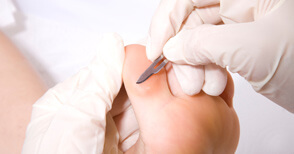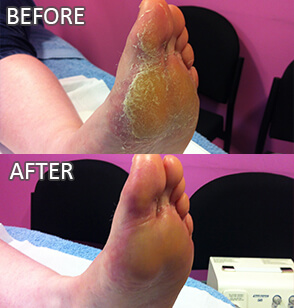What are Corns and Calluses?
 Corns and calluses are one of the most common conditions seen in a foot clinic. They consist of hard thickened skin at places of excess pressure and friction – one of the body’s protection mechanisms against damage.
Corns and calluses are one of the most common conditions seen in a foot clinic. They consist of hard thickened skin at places of excess pressure and friction – one of the body’s protection mechanisms against damage.
Corns are well-defined and cone shaped, with the point of the cone pointing down into the skin and
they tend to occur on bony parts of the feet, especially on the outside of the little toe and the top of
the other toes. Calluses don’t have this cone shape – they’re more dispersed and less well-defined
than corns. Yellowish in colour, they normally form on the bony area of the sole of the foot, just
beneath the toes, or on the heel.
Corns can fall into different types :
- Soft’ corns – so-called because they feel soft compared to the more usual ‘hard’ corn. Soft corns occur between the toes and are kept soft by the moisture that tends to be found here. This type of corn is very painful.
- Seed corns. These are very small and form on the sole of the foot.
- Subungal corns, which form under the nail.
- Neurovascular corns. This type of corn has nerves and blood vessels running through it, and can be relatively difficult to treat.
Causes of Corns and Calluses
Corns and calluses are caused by excessive pressure, or continuous rubbing, on parts of the foot. The reasons for this can either be due to internal or external factors.
These include deformities of the foot such as hammer toes – a condition which causes one or both joints of the second, third, fourth or fifth toes to be bent, resulting in the shoes rubbing against the skin. This friction often leads to the formation of corns.
These, which include tight footwear, are by far the most common cause of corns and calluses. In fact, it’s probably true to say that the majority of all corns are caused by tight footwear – especially high heels.
They might look good, but there’s a cost attached – a high risk of getting corns! Wearers of high heels are at particular risk of corns because the weight of the body pushes the feet downwards, causing the toes to be squashed inside a small space, so that they rub aggressively against the shoe. Corns are often the result. Although the little toe is most often affected, the top-side of all toes can also suffer.
But high heels can also cause the formation of calluses. This is because, normally, the weight of the body (when standing) is distributed over both the balls and heels of the feet. High heels change this weight distribution so that more of the body’s weight is supported by the balls of the feet. This excessive pressure often results in calluses.
There are several typical causes of corns and calluses. In particular:
1. Activities that place considerable pressure on the feet, such as running and walking, can also cause callus formation. This doesn’t mean you need to avoid these activities – only that you should take care in your choice of footwear. Make sure that it fits properly, to minimise the effects of contact between footwear and skin.
2. Worn down fat pads on the soles of the feet. This condition tends to occur as a result of ageing.
3. Prolonged barefoot walking.
4. Flat feet, high arches and an abnormal walking gait can all lead to callus formation
Treatment for Corns and Calluses
 Corns and calluses are not a disease, so although immediate symptomatic relief is good, it’s always important to look for the underlying cause of the problem.
Corns and calluses are not a disease, so although immediate symptomatic relief is good, it’s always important to look for the underlying cause of the problem.
- Physical removal of skin with a surgical blade.
- Chemical removal of skin with Salicylic acid.
- Padding – to help cushion the feet and thus reduce pain and recurrence.
- Orthotics – A special shoe insert that corrects foot posture, and function. Abnormal
foot posture and function can lead to hard skin production. - Subungal corns. These (corns underneath the nail) need professional attention. First, the nail needs to be thinned down, then the corn reduced using a surgical blade.
- Surgery – to correct any bony deformities that are causing the excess pressure on the
feet that leads to hard skin production
Orthotics – Help to correct foot posture and function
How To Prevent Corns & Calluses
 Prevention of corns and calluses is pretty straightforward – it really just means avoiding things that cause excess pressure and rubbing on the feet. As shoes are, arguably, the single biggest cause of problems, getting properly-fitting footwear is essential.
Prevention of corns and calluses is pretty straightforward – it really just means avoiding things that cause excess pressure and rubbing on the feet. As shoes are, arguably, the single biggest cause of problems, getting properly-fitting footwear is essential.
- Shoe shape – When buying shoes, try to make sure that the front is broad and high enough to comfortably accommodate the toes (that is, without being squeezed at the sides or above).
- Buy footwear in the afternoon – This may sound a little strange, but by afternoon the feet have normally swelled a little, so you’ll get a better idea of how well the shoe fits.
- High heels – If you like to wear heels, try and alternate them with lower heeled (ideally flat) shoes – a good idea is to only wear them at work – not on your way to or from work.
